Monthly Expedition Update
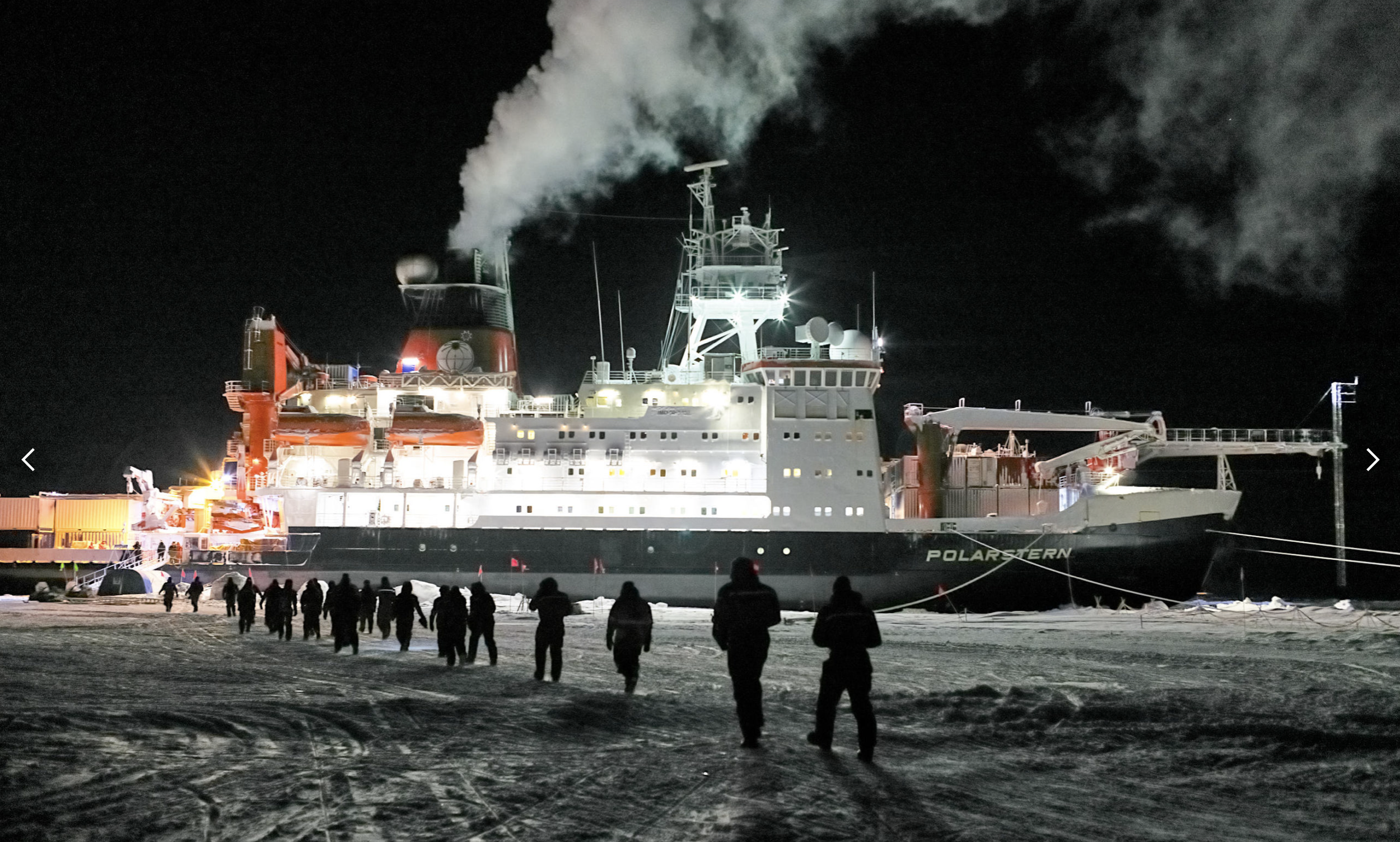
MOSAiC Leg III Begins!
These past few weeks have been about new beginnings for MOSAiC. On February 24th, the Polarstern was a mere 97 miles (156 km) from the North Pole, setting a record for how far north a ship has been able to venture during the Arctic winter. Also, Leg III of the expedition officially kicked off after the supply vessel Kapitan Dranitsyn was able to make it close enough to the Polarstern on February 28th that people and supplies could be transferred between the ships. The Dranitsyn's arrival was delayed due to weather and dense sea ice conditions, but this wasn't completely unexpected. In addition to a fresh group of MOSAiC scientists and crew members, the Dranitsyn also brought with it a supply of fresh fruit, something MOSAiC participants aboard the Polarstern hadn't seen in nearly a month! Photo (left): MOSAiC Leg III participants board the Polarstern; Photo credit: Michael Gutsche
What's involved in a MOSAiC expedition shift change and resupply mission?
Return of the Sun
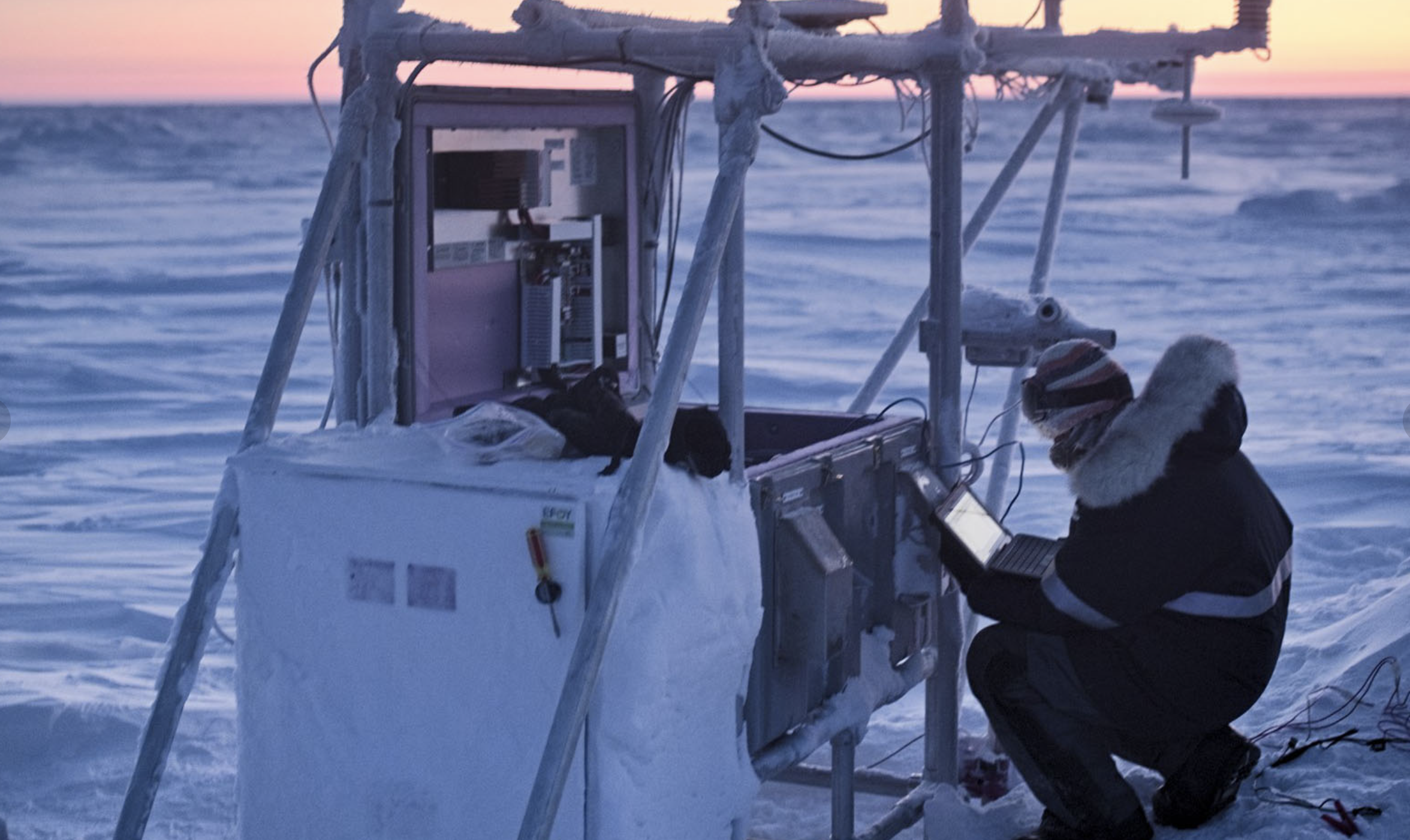
Another exciting new beginning for MOSAiC participants that happened this past week is the return of the sun! For almost 5 months, the expedition in the Arctic has been in total darkness except for the occasional full moon and the beginnings of 'nautical' twilight a couple of weeks ago. But on March 12, MOSAiC participants aboard the Polarstern reported that the sun is back, although it is currently obscured behind Arctic clouds. Photo (right): A MOSAiC team member performs maintenance on a scientific instrument during nautical twilight; Photo credit: Michael Gallagher
Did you miss our last MOSAiC Monday about Arctic clouds? Check it out here!
 In the classroom: MOSAiC Math
In the classroom: MOSAiC Math
Your challenge, if you choose to accept it: Can you solve some or all of the following MOSAiC math problems? Check out next week's MOSAiC Monday for the answers.
1. On February 24th, the Polarstern was 97 miles (156 km) from the North Pole. If you jumped on a snowmobile and headed out from the Polarstern straight towards the North Pole going 35 miles/hour, how long would it take you to get there? How much time would you save if you traveled at 55 miles/hour?
2. On March 9th, MOSAiC participants reported that a large crack, or lead, in the ice opened up about a mile from the Polarstern. The lead was about 3 miles (~5 km) long and about 545 yards (~500 m) wide. How much of the ocean's surface area was exposed by the opening of this lead? Remember that there are 1,760 yards in 1 mile.
3. It was reported that MOSAiC Leg II participants ate nearly 3,000 lbs (~1,360 kg) of potatoes! If an average potato weighs ~0.5 lbs, how many potatoes did Leg II participants eat?
![]()
Caution, Preparedness, and Wellbeing on MOSAiC
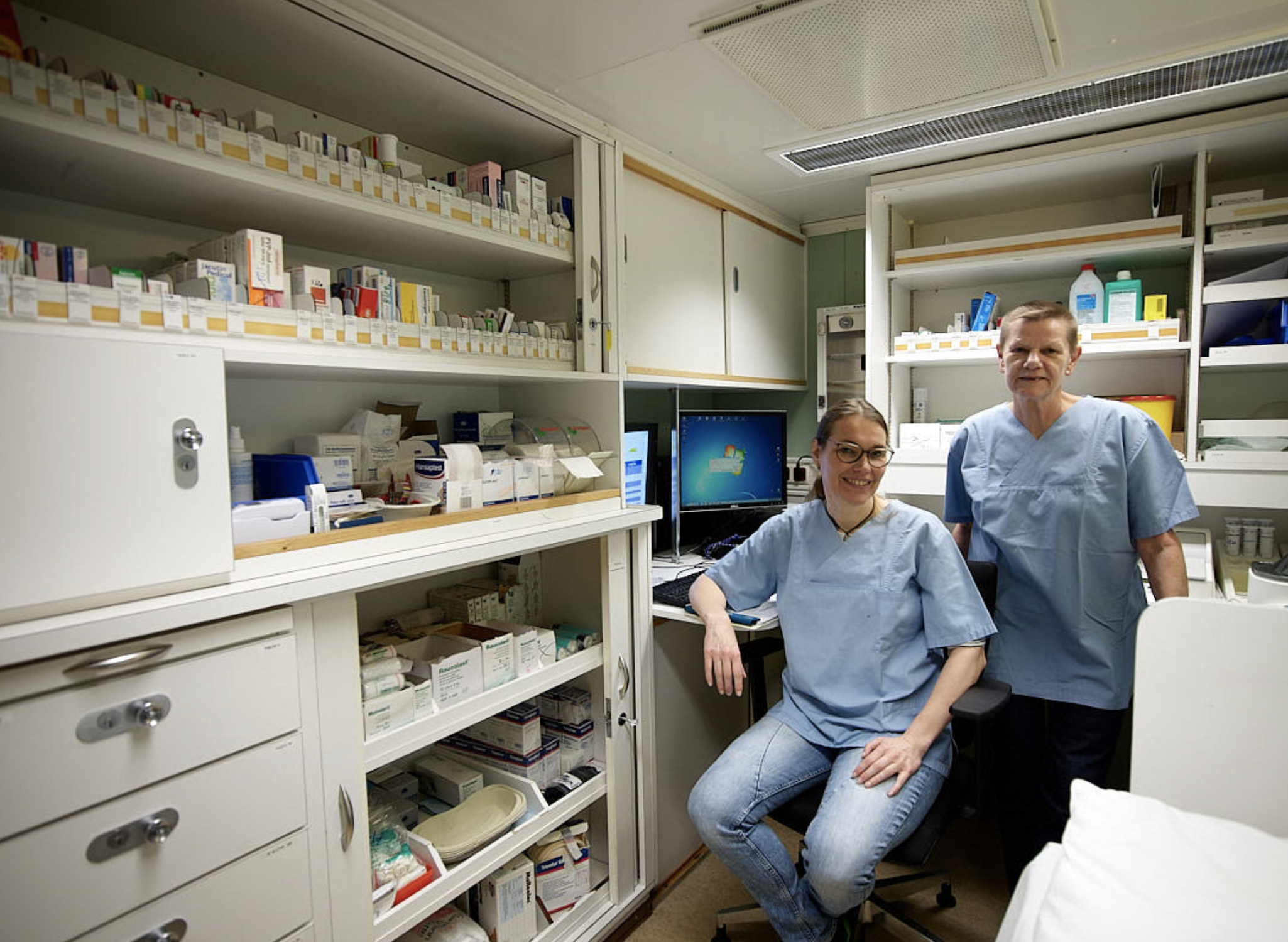
Countries and communities around the globe are taking precautions to slow the spread of COVID-19, and MOSAiC is doing the same. The Polarstern's remote location in the middle of the Arctic Ocean far away from civilization doesn't make it immune from a viral outbreak, as every few months a new group of scientists and crew members from around the world join the expedition on board the ship. There is a doctor and nurse on board the icebreaker at all times, and the Polarstern is equipped with a doctor's office, surgery room, emergency station, and accommodations for patients. The doctor's office is stocked with medicines and medical equipment. However, MOSAiC participants who haven't yet joined the expedition are taking abundant precautionary measures to make sure the virus doesn't make it onto the ship in the first place: testing, precautionary quarantines (if necessary), and precautionary behavioral measures (such as social distancing and diligent hand washing). The expedition has already been impacted by COVID-19 as a member of the aircraft team who has not yet joined the expedition tested positive for the virus. The component of the expedition impacted by this, an air mission to collect atmospheric samples in the Arctic, has subsequently been delayed - you can read more about this in the article below. So far the ship itself has not been affected, and the goal is to keep it that way. Photo: For Leg III of the expedition, surgeon and emergency doctor Petra Gössmann-Lange and intensive care and anesthesia nurse Tina Wöckener have taken over medical responsibilities aboard the Polarstern; Photo credit: Michael Gutsche
Article: Coronavirus crisis hits ice-locked Arctic research expedition
Virtual Educational Resources for Polar Topics
We know that a lot of teachers and classrooms are having to switch to remote and virtual learning as a result of COVID-19. Here are some polar and MOSAiC-related virtual and online resources you can use to keep your students connected to the Arctic and MOSAiC expedition:
Just launched: MOSAiC MOOC on Coursera!
We're excited to announce the launch of Frozen in the Ice: Exploring the Arctic, a new massive open online course (MOOC) about the MOSAiC expedition now available to anyone on Coursera! This course is composed of over 40 video lectures from MOSAiC scientists and crew covering topics from sea ice, to Arctic geopolitics, to climate modeling. Learn how MOSAiC scientists are studying the Arctic climate system and what the goals of each of the MOSAiC science teams are. Engage with a community of other learners interested in the topic through discussion boards and more!
Go to Frozen in the Ice: Exploring the Arctic on Coursera
Explore Arctic processes with the Fluid Earth Viewer
The Fluid Earth Viewer (FEVer) is an interactive web application that allows you to visualize current and past conditions of Earth’s atmosphere and oceans. Now you can find the real-time location of the Polarstern in the viewer! See what conditions are like for the current MOSAiC expedition participants - air temperature, ocean currents, wind, sea surface temperature, and more. Teachers, your students can use this interactive web app to track conditions in the Arctic over time or to see how different variables compare or change together.
Go to Fluid Earth Viewer interactive web app
Sea Ice Portal from the Alfred Wegener Institute
Looking for maps and data about sea ice from the MOSAiC expedition? Look no further than the Alfred Wegener Institute's Sea Ice Portal (meereisportal.de/seaiceportel.de). Watch the daily updated time-lapse video of the Polarstern's ship radar (direct link here), check out satellite maps of the Arctic with the Polarstern's track (direct link here), and explore other map and data products, including buoy locations and trajectories (direct link here).
Arctic and Antarctic Classroom Resources from the National Science Foundation
The National Science Foundation's Arctic and Antarctic Classroom Resources website is a treasure trove of educational resources for students of all ages related to the Arctic and Antarctica. Watch videos about Arctic food webs under the sea ice, find polar-related games, stories, readings, puzzles, and songs to engage your students with, and connect your students to polar scientists through virtual programs.
Go to NSF Arctic and Antarctic Classroom Resources page
 #askmosaic: Finding Comfort in a Remote Place
#askmosaic: Finding Comfort in a Remote Place
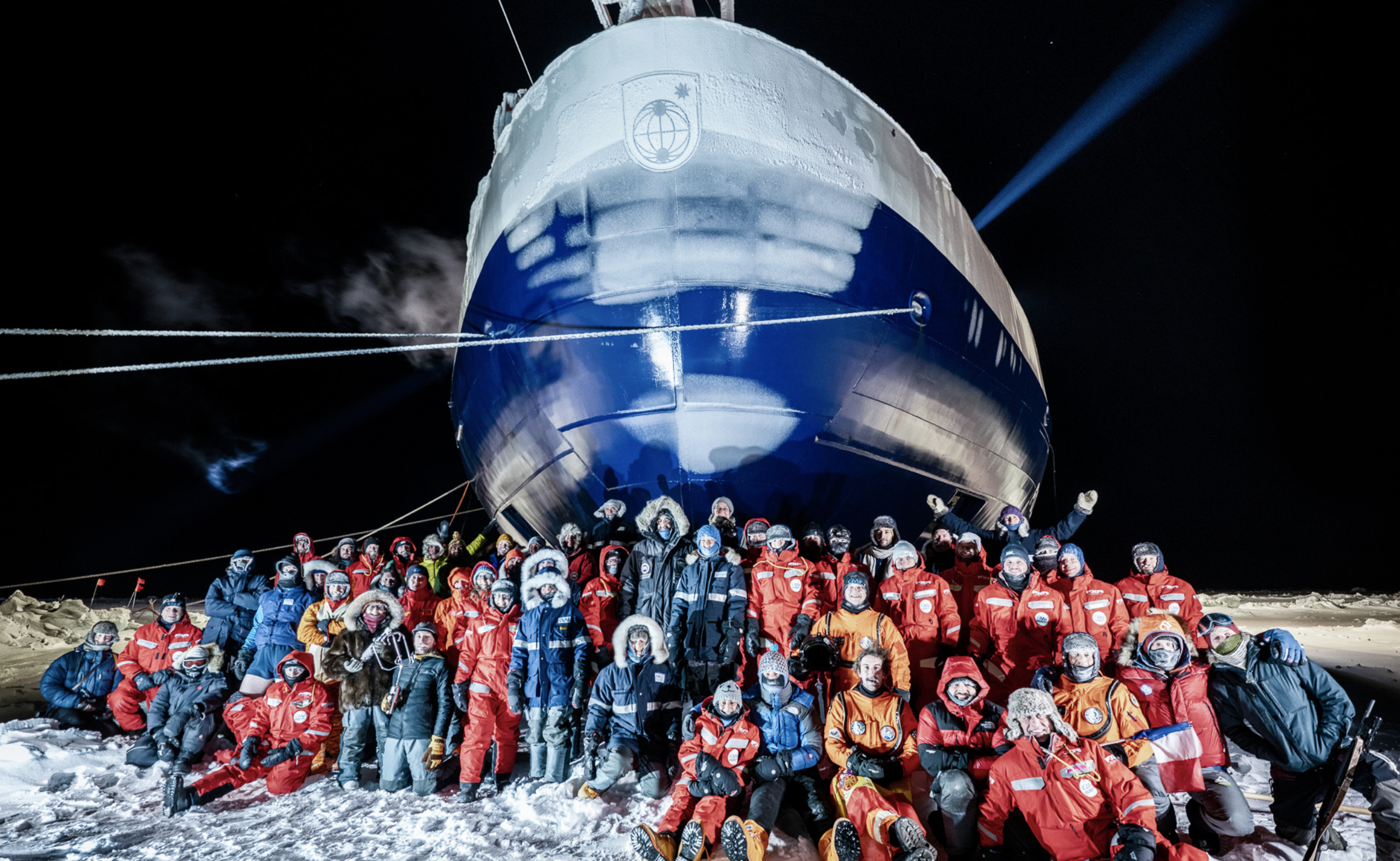
This question was submitted by Jill from Middleton Middle School: When you left, did you miss your family? I know I would. Do you get to talk to them?
Leaving my family was absolutely the worst part of taking part in the MOSAiC expedition for me. I travel to the polar regions to do fieldwork often and it never is easy to leave my family behind. I even missed my daughter's 11th birthday while I was away on the MOSAiC expedition, although we did have her birthday party before I left the US. I have lots of family photos on my iPad and I look at these every night before I go to sleep. That helps me feel just a little less far away from the people I love.
While we were traveling to the Polarstern on the Russian icebreaker the Kapitan Dranitsyn, we only had access to WhatsApp to send messages to our family, so for the 5 weeks that I was on that ship I couldn't call home to talk to my wife or daughter. But, we did send messages every day and I was able to hear about all of the things they were doing at home and I could tell them what I was doing each day. Now that I am on the Polarstern I can still send messages with WhatsApp but I can also send text-only e-mail messages, and we have access to a satellite phone we can use to call home, although these calls cost about $0.50 per minute.
-John Cassano, University of Colorado Boulder, MOSAiC Team Atmosphere. John is currently on board the Polarstern for Leg III of the expedition.
Photo: MOSAiC Leg II participants in front of the Polarstern; Photo credit: Lukas Piotrowski
Kyle from Middleton Middle School wants to know: How do you sleep in such cold conditions?
Actually, it's very warm inside the ship and our cabins are very comfortable. Just like your room at home. The ship has plenty of electrical power for heat, lights, computers and everything else. But to work outside in the cold we need to put on a lot of specialized clothing and safety gear! Usually, we don't stay outside longer than 4-5 hours at a time.
-Byron Blomquist, University of Colorado Boulder/NOAA, MOSAiC Team Atmosphere. Byron was on Leg I of the expedition.
Submit your #askmosaic questions!
 MOSAiC Weekly Tracking
MOSAiC Weekly Tracking
Plot the Polarstern
Each week we will provide you with the latitude and longitude coordinates of the Polarstern so that your students can track its journey across the Arctic in your classroom.
Download the map to plot coordinates
Download a larger map of the Arctic for a bigger picture view of the expedition area
Location of the Polarstern
| Date | Latitude | Longitude |
| September 16, 2019 | 69.68 N | 18.99 E |
| September 23, 2019 | 72.31 N | 26.93 E |
| September 30, 2019 | 85.12 N | 138.05 E |
| October 4, 2019** | 85.08 N | 134.43 E |
| October 7, 2019 | 85.10 N | 133.82 E |
| October 14, 2019 | 84.85 N | 135.03 E |
| October 21, 2019 | 84.97 N | 132.73 E |
| October 28, 2019 | 85.47 N | 127.07 E |
| November 4, 2019 | 85.88 N | 121.70 E |
| November 11, 2019 | 85.82 N | 116.00 E |
| November 18, 2019 | 86.05 N | 122.43 E |
| November 25, 2019 | 85.85 N | 121.35 E |
| December 2, 2019 | 85.97 N | 112.95 E |
| December 9, 2019 | 86.25 N | 121.40 E |
| December 16, 2019 | 86.62 N | 118.12 E |
| December 23, 2019 | 86.63 N | 113.20 E |
| December 30, 2019 | 86.58 N | 117.13 E |
| January 6, 2020 | 87.10 N | 115.10 E |
| January 13, 2020 | 87.35 N | 106.63 E |
| January 20, 2020 | 87.42 N | 97.77 E |
| January 27, 2020 | 87.43 N | 95.82 E |
| February 3, 2020 | 87.42 N | 93.65 E |
| February 10, 2020 | 87.78 N | 91.52 E |
| February 17, 2020 | 88.07 N | 78.52 E |
| February 24, 2020 | 88.58 N | 52.87 E |
| March 2, 2020 | 88.17 N | 31.02 E |
| March 9, 2020 | 87.93 N | 24.20 E |
| March 16, 2020 | 86.87 N | 12.70 E |
**Day when MOSAiC reached the ice floe that the Polarstern will become frozen in and drift with for the next year.
Log MOSAiC Data
Keep track of Arctic conditions over the course of the expedition:
Download Data Logbook for Sept. 2019 - Dec. 2019
Download Data Logbook for Dec. 2019 - Mar. 2020
| Date | Length of day (hrs) | Air temperature (deg C) at location of Polarstern | Arctic Sea Ice Extent (million km2) |
| September 16, 2019 | 13.25 | High: 10 Low: 4.4 | 3.9 |
| September 23, 2019 | 12.35 | High: 6 Low: -1 | 4.1 |
| September 30, 2019 | 9.1 | -4.7 | 4.4 |
| October 4, 2019** | 6.27 | -13.0 | 4.5 |
| October 7, 2019 | 3.05 | -8.2 | 4.6 |
| October 14, 2019 | 0 | -14.7 | 4.8 |
| October 21, 2019 | 0 | -12.8 | 5.4 |
| October 28, 2019 | 0 | -18.3 | 6.8 |
| November 4, 2019 | 0 | -18.9 | 8.0 |
| November 11, 2019 | 0 | -25.5 | 8.7 |
| November 18, 2019 | 0 | -10.7 | 9.3 |
| November 25, 2019 | 0 | -18.4 | 10.0 |
| December 2, 2019 | 0 | -26.6 | 10.4 |
| December 9, 2019 | 0 | -23.1 | 11.2 |
| December 16, 2019 | 0 | -19.2 | 11.8 |
| December 23, 2019 | 0 | -26.9 | 12.2 |
| December 30, 2019 | 0 | -26.4 | 12.6 |
| January 6, 2020 | 0 | -28.0 | 13.0 |
| January 13, 2020 | 0 | -30.7 | 13.1 |
| January 20, 2020 | 0 | -27.1 | 13.6 |
| January 27, 2020 | 0 | -22.5 | 13.8 |
| February 3, 2020 | 0 | -28.8 | 14.1 |
| February 10, 2020 | 0 | -26.2 | 14.5 |
| February 17, 2020 | 0 | -31.9 | 14.4 |
| February 24, 2020 | 0 | -24.0 | 14.6 |
| March 2, 2020 | 0 | -35.5 | 14.8 |
| March 9, 2020 | 0 | -37.9 | 14.7 |
| March 16, 2020 | 10.5 | -27.5 | 14.7 |
*Note: We expect data to fall within the following ranges: Length of day, 0-24 hours; Temperature, -40 to 14 degrees C; Sea ice extent, 3-15 million km2
**Day when MOSAiC reached the ice floe that the Polarstern will become frozen in and drift with for the next year.
Contribute to the Museum of MOSAiC Art (MoMOA)
Do you like to draw, paint, sculpt, take photos, build models, knit, sew, write poetry, or engage in any other kind of creative endeavor? We want you to send us photos or scans of your MOSAiC-themed artwork! You can use any artistic medium you like and submit as many creations as you wish to the following categories:
- How the Arctic affects you
- Arctic exploration
- People of the Arctic
- MOSAiC science
- Arctic flora and fauna
- Arctic land and seascapes
- Life on an Arctic icebreaker
- Abstract Arctic
- Other
We'll be showcasing your artwork in the new virtual Museum of MOSAiC Art (MoMOA). Submit photos or scans of your artwork using the submission form below (open to all ages)!
Submit your artwork
Check out the Museum of MOSAiC Art
Questions? Email us with the subject line "MOSAiC Art": mosaic@colorado.edu
Opportunities for Students and Educators
MOSAiC + Reach the World
Exciting news! The MOSAiC education & outreach team has partnered with Reach the World to connect more classrooms to the MOSAiC expedition. Over the coming months, Reach the World will share MOSAiC team members' incredible stories about the expedition, its research, and the everyday challenges of life in the Arctic.
Happening now: MOSAiC expedition team members Sara Morris and Jessie Creamean share what it's like to collect data and samples from the Arctic. They'll be publishing their blogs on Reach the World's MOSAiC expedition homepage, and Jessie will be participating in a classroom video call on March 17th and 1:00 pm Eastern Time. Sign up for an on-camera spot here!
Learn more from Sara and Jessie on Reach the World's MOSAiC expedition page
Watch Jessie's classroom video call live on March 17
Iceland: Nature Untamed Summer Experience for Middle Schoolers
Iceland, a land of natural wonders, is also a land of change, some of it good, some of it not so good. On this 11-day journey (June 23 - July 3) with a science expert from The New York Times, see how this transformation, some of it linked to climate change, shows up in its glaciers, waterfalls and thermal pools, and how Iceland is dealing with it. Seventh and eighth graders can get an inside look into how a small nation deals with some of the problems the rest of the world faces in this immersive experience.
Follow the 2020 PolarTREC Expedition With the International Arctic Buoy Programme
Follow PolarTREC educator Sarah Johnson as she joins the Arctic Science Expedition team with the International Arctic Buoy Programme this spring and summer to deploy buoys in the Arctic Ocean. Buoys are invaluable instruments that provide meteorological and oceanographic data for all sorts of purposes: scientific research, weather forecasting, climate model validation, and more!
Follow Sarah's blog and social media posts
Learn more about PolarTREC and the International Arctic Buoy Programme
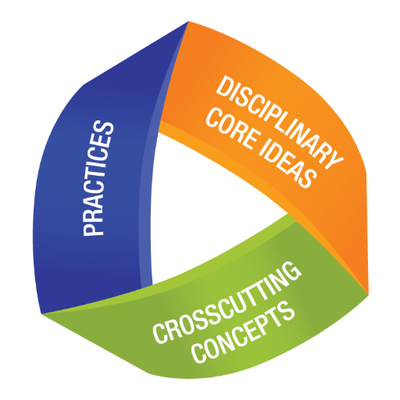 MOSAiC Monday and the NGSS
MOSAiC Monday and the NGSS
What do those funny symbols below some engagements mean?
Good news for educators in the U.S. teaching with the Next Generation Science Standards (NGSS) or similar! We will now be tagging MOSAiC Monday engagements with the NGSS Disciplinary Core Idea subject(s), Science and Engineering Practice(s), and Crosscutting Concept(s) that they most closely connect to. Look for these symbols listed below each engagement:
Disciplinary Core Idea Subjects
Science and Engineering Practices (adopted from the San Diego County Office of Education Science Resource Center)
Crosscutting Concepts (adopted from the San Diego County Office of Education Science Resource Center)
Is there something you'd like to see in MOSAiC Monday? Let us know!
Send us your feedback
New to MOSAiC Monday? Check out past editions!
Browse more expedition-related educational resources, videos, and blogs
Email us! mosaic@colorado.edu
